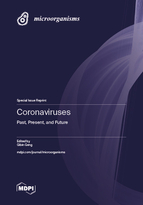Coronaviruses: Past, Present, and Future
A special issue of Microorganisms (ISSN 2076-2607). This special issue belongs to the section "Public Health Microbiology".
Deadline for manuscript submissions: closed (31 January 2024) | Viewed by 96064
Special Issue Editor
Interests: virus; host; structure; biology; cells; biochemistry; protein; gene; vaccines; immunology
Special Issues, Collections and Topics in MDPI journals
Special Issue Information
Dear Colleagues,
It can be a challenging task to reflect on the last three years. We are stepping into the fourth year of a pandemic, and most countries have experienced successive waves of SARS-CoV-2 infection. It is time to reflect on our past and contemplate the future. The first human coronavirus (HCoV) was isolated in 1965 from a patient with a common cold. Since then, seven HCoVs have been identified. Like the SARS-related coronavirus strain implicated in the 2003 SARS outbreak, SARS-CoV-2, the causative agent of COVID-19, is an enveloped positive-strand RNA(+ssRNA) virus. The SARS-CoV-2 genome encodes four structural proteins. Of them, the spike protein is not only involved in binding to the human ACE2 receptor and cell entry, but the most targeted region by antibodies (even vaccines). Despite the error-correcting machinery, mutations could occur in the SARS-CoV-2 genome. The most concerning mutations are associated with a fitness advantage to the virus, which may lead to lineage expansion. Besides, the virus could also accumulate mutations during prolonged infection in immunocompromised patients and when the human passage of the virus to animals. Currently, the Omicron variant of SARS-CoV-2 and its subvariants, which are pretty different from the original strain or other previous variants in many respects, is rapidly spreading around the world when it unexpectedly emerged a year ago, and there is still so much uncertainty around what it could do next. Omicron has the innate ability to evade the therapeutic antibodies and immune protection from prior COVID-19 infection and vaccination. Most worryingly, Omicron has shown no sign of slowing down and continues to rapidly mutate and generate new subvariants with immune-evasive properties like BA.5, BQ.1, BA.2.75.2, and XBB. Despite these headwinds, we have had vaccines and treatments available against COVID-19, despite reduced efficacy towards emerging variants. Improvements are still warranted toward the understanding of coronavirus infection and the new prophylaxis and therapeutic agents that can rapidly pivot to combat new viral variants or even new viruses that might drive the next pandemic. For this Special Issue, we will be excited to see the advances, thoughts, and experiences related to the coronavirus family. Original research or review articles are warmly welcomed.
Dr. Qibin Geng
Guest Editor
Manuscript Submission Information
Manuscripts should be submitted online at www.mdpi.com by registering and logging in to this website. Once you are registered, click here to go to the submission form. Manuscripts can be submitted until the deadline. All submissions that pass pre-check are peer-reviewed. Accepted papers will be published continuously in the journal (as soon as accepted) and will be listed together on the special issue website. Research articles, review articles as well as short communications are invited. For planned papers, a title and short abstract (about 100 words) can be sent to the Editorial Office for announcement on this website.
Submitted manuscripts should not have been published previously, nor be under consideration for publication elsewhere (except conference proceedings papers). All manuscripts are thoroughly refereed through a single-blind peer-review process. A guide for authors and other relevant information for submission of manuscripts is available on the Instructions for Authors page. Microorganisms is an international peer-reviewed open access monthly journal published by MDPI.
Please visit the Instructions for Authors page before submitting a manuscript. The Article Processing Charge (APC) for publication in this open access journal is 2700 CHF (Swiss Francs). Submitted papers should be well formatted and use good English. Authors may use MDPI's English editing service prior to publication or during author revisions.
Keywords
- COVID-19
- SARS-CoV-2
- coronavirus infection
- life cycle
- epidemiology
- vaccines
- treatments
- pathogenicity
- animal models
- mutants or variants
- interspecies transmission
Benefits of Publishing in a Special Issue
- Ease of navigation: Grouping papers by topic helps scholars navigate broad scope journals more efficiently.
- Greater discoverability: Special Issues support the reach and impact of scientific research. Articles in Special Issues are more discoverable and cited more frequently.
- Expansion of research network: Special Issues facilitate connections among authors, fostering scientific collaborations.
- External promotion: Articles in Special Issues are often promoted through the journal's social media, increasing their visibility.
- Reprint: MDPI Books provides the opportunity to republish successful Special Issues in book format, both online and in print.
Further information on MDPI's Special Issue policies can be found here.







